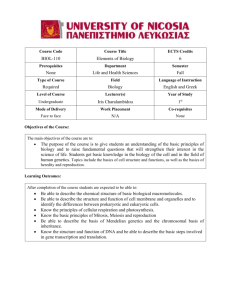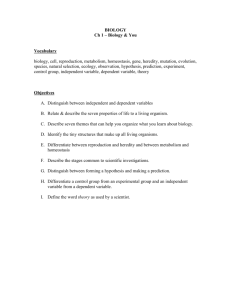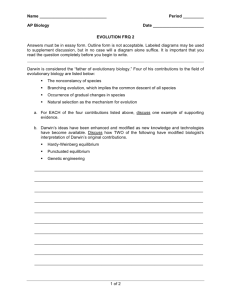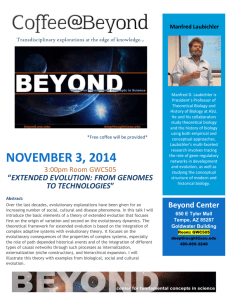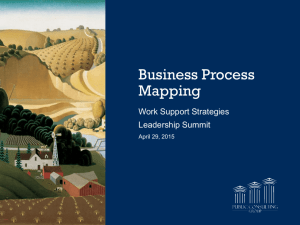MS Word - University of Maine System
advertisement
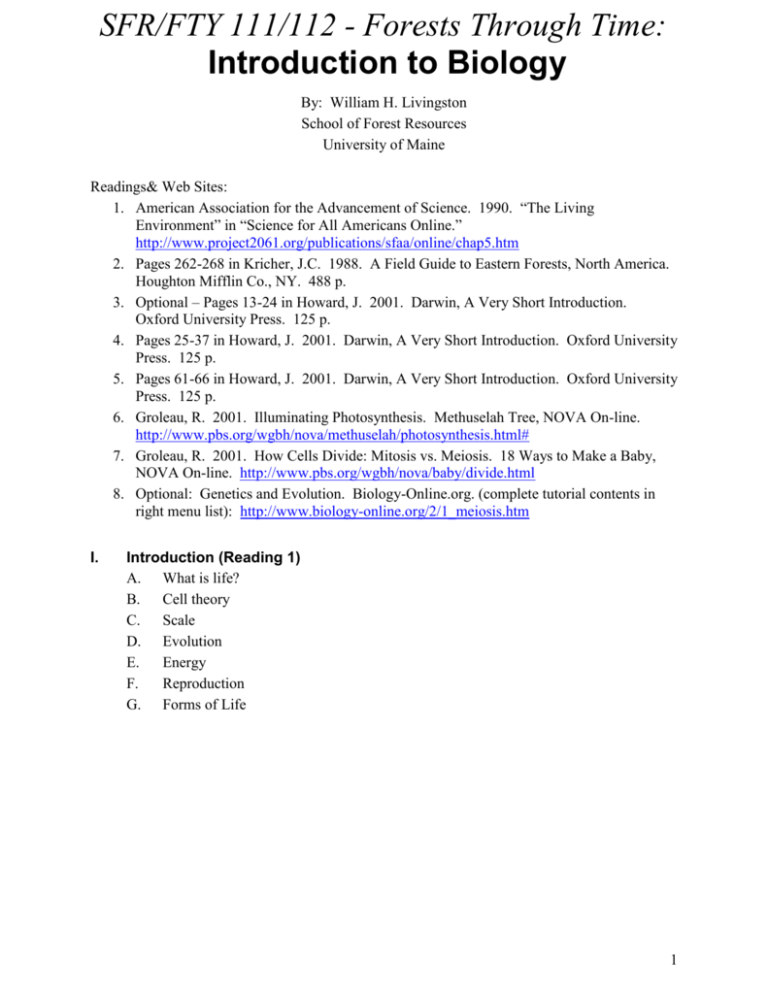
SFR/FTY 111/112 - Forests Through Time: Introduction to Biology By: William H. Livingston School of Forest Resources University of Maine Readings& Web Sites: 1. American Association for the Advancement of Science. 1990. “The Living Environment” in “Science for All Americans Online.” http://www.project2061.org/publications/sfaa/online/chap5.htm 2. Pages 262-268 in Kricher, J.C. 1988. A Field Guide to Eastern Forests, North America. Houghton Mifflin Co., NY. 488 p. 3. Optional – Pages 13-24 in Howard, J. 2001. Darwin, A Very Short Introduction. Oxford University Press. 125 p. 4. Pages 25-37 in Howard, J. 2001. Darwin, A Very Short Introduction. Oxford University Press. 125 p. 5. Pages 61-66 in Howard, J. 2001. Darwin, A Very Short Introduction. Oxford University Press. 125 p. 6. Groleau, R. 2001. Illuminating Photosynthesis. Methuselah Tree, NOVA On-line. http://www.pbs.org/wgbh/nova/methuselah/photosynthesis.html# 7. Groleau, R. 2001. How Cells Divide: Mitosis vs. Meiosis. 18 Ways to Make a Baby, NOVA On-line. http://www.pbs.org/wgbh/nova/baby/divide.html 8. Optional: Genetics and Evolution. Biology-Online.org. (complete tutorial contents in right menu list): http://www.biology-online.org/2/1_meiosis.htm I. Introduction (Reading 1) A. What is life? B. Cell theory C. Scale D. Evolution E. Energy F. Reproduction G. Forms of Life 1 SFR/FTY 111/112 - Forests Through Time: Introduction to Biology II. What is Biology? What is Life? (Reading 1) A. Basis for biological sciences developed in 1800’s. B. Life utilizes energy. C. Life reproduces. D. Life evolves. III. Cell theory. (Reading 1) A. All living things composed of cells B. All living things arise from cells C. Must have IV. Scale - Level of biological organization, classifications A. Atoms: B. Molecule: C. Cell: D. Tissue: E. Organ: F. Organism: G. Species. H. Populations: 2 SFR/FTY 111/112 - Forests Through Time: Introduction to Biology V. Evolutionary theory (Darwin 1859) – core theme in biology. (Readings 1, 2, 4, 5) A. Evolutionary change – life forms keep changing B. Natural selection – mechanism of evolutionary change 1. Explains process involved in changing species 2. Has three generalizations. a) Variability 3. 4. b) Inheritability. c) Excess progeny Consequences of these 3 generalizations a) Surviving individuals are NOT drawn at random b) As the environment changes, what’s needed for adaptation changes c) Populations adapt to environment, not individuals. Is it survival of the “fittest”? 3 SFR/FTY 111/112 - Forests Through Time: Introduction to Biology VI. 5. Environmental change includes changing populations of species 6. Species descended from a common ancestor Evolution Review A. Natural Selection is the mechanism 1. All individuals vary. 2. Offspring inherit genes (traits) from both parents 3. Excess progeny - best adapted survive to reproduce B. Conditions change, so must populations C. Species evolve from common ancestor VII. Energy and Life (Readings 1, 6) A. The basics. 1. Atoms and molecules B. 2. Movement of electrons can produce energy. 3. Light is energy 4. Photons can be absorbed by electrons – Photosynthesis stores light energy as chemical energy. 1. Light photons hit electrons in chlorophyll, the green pigment in leaves 2. Starts a chain reaction that pulls electrons and hydrogen off of water – oxygen is released 3. Electrons and hydrogen transferred to carbon dioxide 4 SFR/FTY 111/112 - Forests Through Time: Introduction to Biology C. Respiration and burning involve transferring electrons and hydrogen from carbon to oxygen 1. After all electrons and hydrogens are removed from the carbon, 2. D. When electrons and hydrogens are joined with oxygen, water forms a) In cells b) In fire All energy for life comes from what plants can store after photosynthesis VIII. Reproduction (Readings 5, 7, 8) A. All cells come from cells 1. Instruction for making a cell found on DNA 2. DNA seen as chromosomes in cells B. 3. Haploid cells 4. Diploid cells Mitosis: cell divides to form 2 identical cells 5 SFR/FTY 111/112 - Forests Through Time: Introduction to Biology C. Sexual reproduction 1. Fertilization 2. D. Alternation between fertilization and meiosis creates genetic diversity 1. Meiosis creates new combination of genes never seen before 2. 3. IX. Meiosis Fertilization brings together unique sequences of genes – genes keep getting mixed. More diversity = better adapted for natural selection Major Forms of Live A. Viruses B. Prokaryotic C. Eukaryotic 1. Cell membrane and cytoplasm 2. DNA molecules in a nucleus 3. Four groups a) Protista 6 SFR/FTY 111/112 - Forests Through Time: Introduction to Biology b) Fungi c) Plants (i) Have a cell wall (ii) Forms specialized cells and tissues (iii) Gets: d) (iv) Reproduction Animals (i) No cell wall (ii) Ingests food (iii) Specialized tissues, especially for motility (iv) Reproduction by fertilization 7 SFR/FTY 111/112 - Forests Through Time: Introduction to Biology X. Names A. Scientific and common B. Scientific names based on evolutionary relationships C. XI. Species basic unit Conclusion A. Evolution and energy utilization characterize life 1. Natural selection explains how life evolved 2. Life depends solely on energy stored from photosynthesis B. Sexual reproduction ensure variation that favors natural selection C. Major forms of life: 1. Viruses 2. Bacteria 3. Protista 4. Fungi 5. Plants 6. Animals 8 SFR/FTY 111/112 - Forests Through Time: Introduction to Biology Terms Adapts Algae Amoeba Animals Atoms Bacteria Biology Burning Carbon dioxide Cell theory Cell theory. Cell wall Cell. Chemical energy. Chlorophyll Chromosomes Circulatory system Common ancestor Conifers Cytoplasm Darwin Diatoms Diploid cells DNA Egg Electrons Energy Eukaryotic Evolution Evolutionary change Evolutionary theory Excess progeny Ferns Fertilization Flowers Fungi Gene Genetic diversity Haploid cells Hardwoods Hydrogen Ingests food Inheritability. Lichens Life Light energy Major Forms of Live Meiosis Membrane Mitosis: Molecule Mosses Muscle structure Mushrooms Mycorrhizae Natural selection Nervous system Neutrons Nucleus Nutrients Organ Organism Oxygen Photons Photosynthesis Plants Populations Prokaryotic Protista Protons Reproduction Respiration Respiratory system Seeds Sexual reproduction Skeletal structure Soil Species Sperm Spores Sugar Tissue Variability Viruses Water Zygote 9



